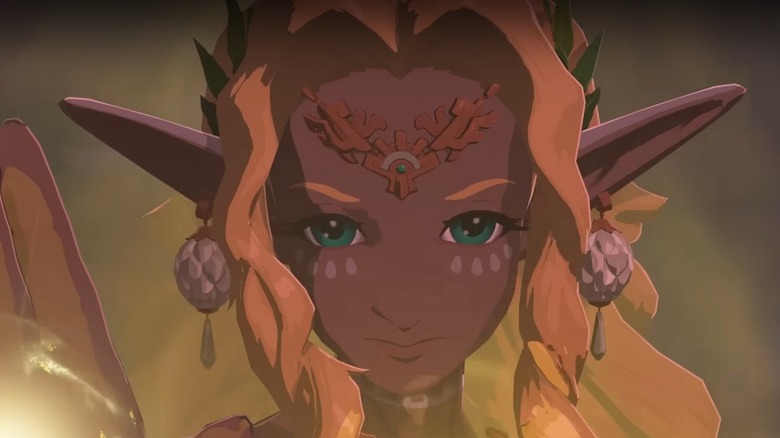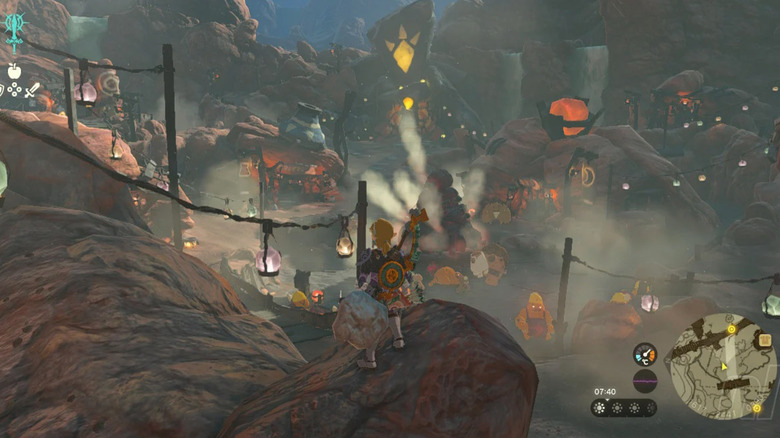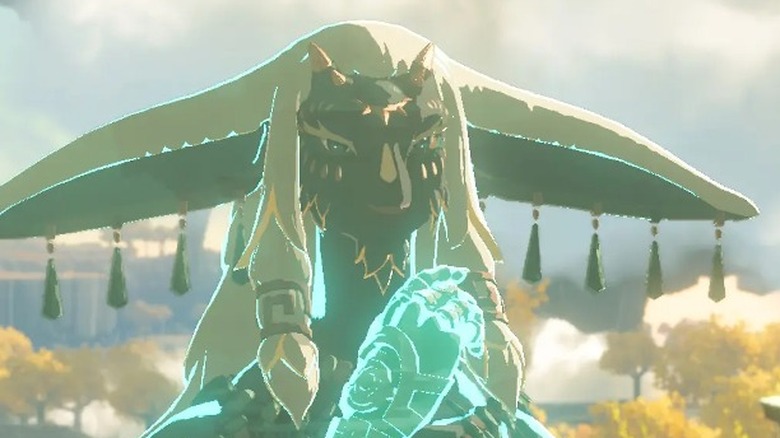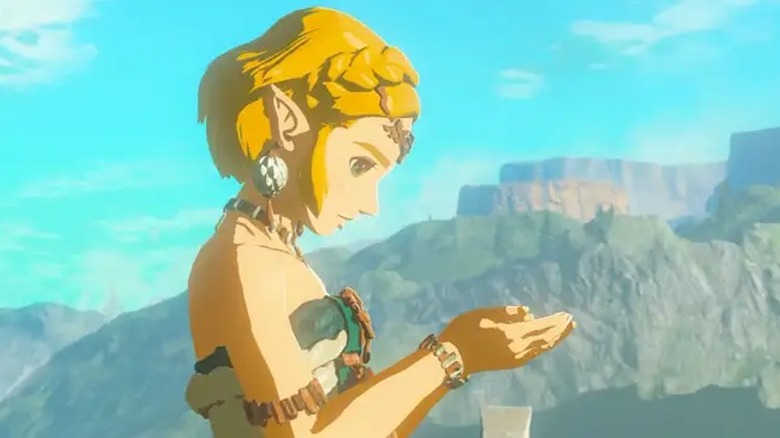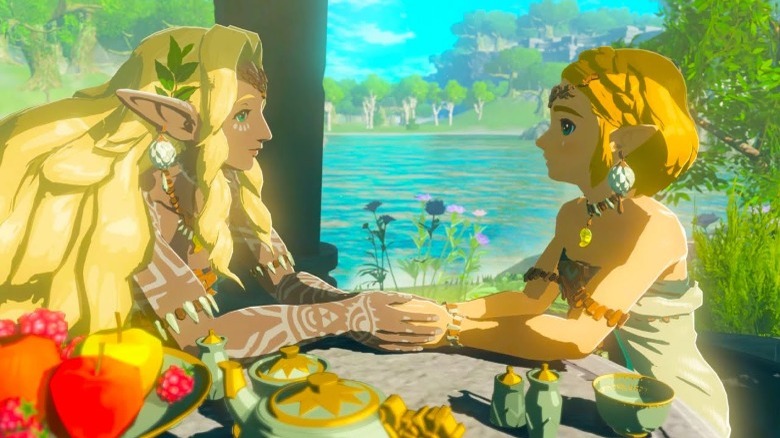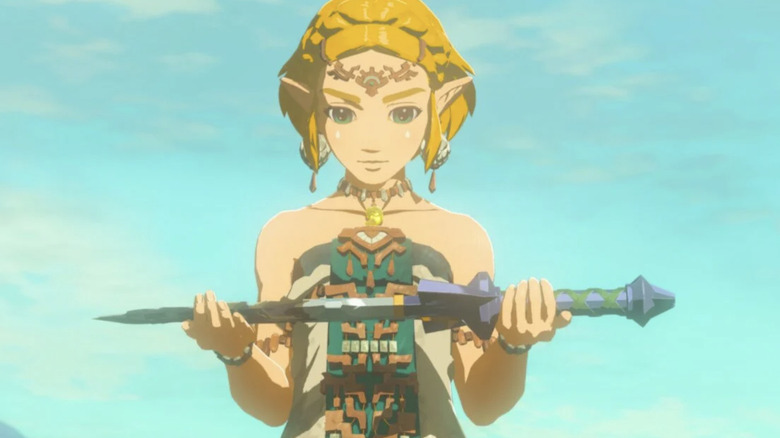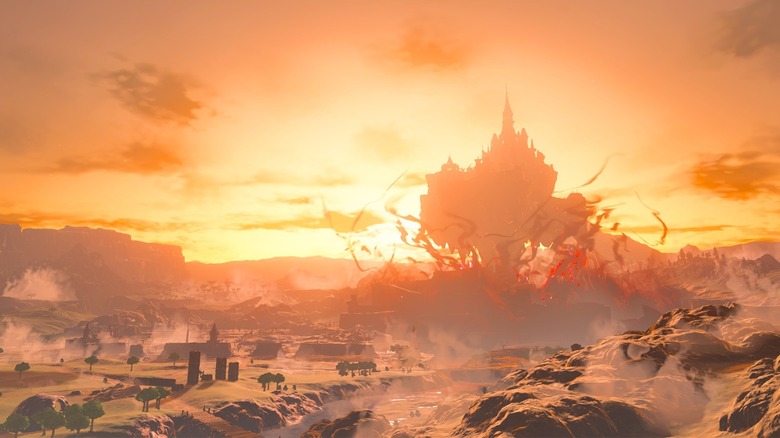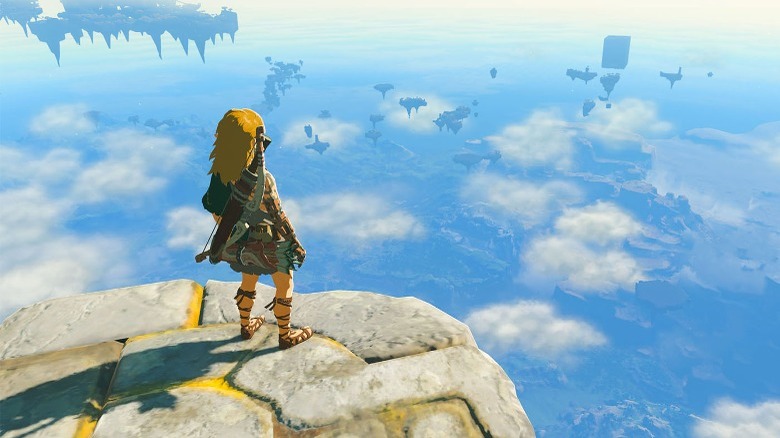Unanswered Questions We Have About Zelda: Tears Of The Kingdom
"Zelda" fans waited a long time for "Tears of the Kingdom," and it finally released to critical acclaim in May 2023. SVG's own review of the latest "Legend of Zelda" game specifically points out that the open world of Hyrule will take some time to explore, and with such a sprawling landscape comes plenty of things to speculate about. While "Tears of the Kingdom" answers many of the questions asked at the beginning of the game, plenty of loose threads remain after its final scene.
Fan theories play an essential role in the "Legend of Zelda" series, shaping the ways in which gamers interact with its lore. Plenty of theories focus on what players don't see in the games, but others have popped up around questions raised in side quests, unused areas, or simply the world itself.
"Tears of the Kingdom" continues this tradition by providing excellent fodder for fan theories. With Hyrule in shambles and the princess missing, more than one thing has gone awry, and even though the game is massive, there simply isn't time to solve everything. Here are some of the biggest unanswered questions in "Tears of the Kingdom."
Is climate change a factor in Hyrule?
It's safe to say that Hyrule is not having a good time after the Upheaval. Islands have appeared in the sky, and everywhere Link goes there are chunks of rock falling from above. Though the locals seem relatively unfazed, it's clear something bad is happening — and it might be getting even worse.
"Tears of the Kingdom" isn't necessarily an allegory for climate change, but it's difficult to ignore that the balance of nature has gone awry in Hyrule. Each Regional Phenomenon Purah tasks Link with investigating revolves around some weather-related issue. Sludge falls from the sky onto Zora's Domain, the Gerudo Desert experiences blazing sandstorms, Goron City isn't as hot as it used to be (allowing travelers to visit), and Rito Village sits in a bitter blizzard, cutting it off from the rest of the world. All of that could be related to the emerging evil of Ganondorf, but it also sounds a lot like climate change. Unfortunately, "Tears of the Kingdom" never outright answers this dilemma, allowing players to draw their own conclusions.
Fran Ruiz noted the connections between the real world and "Tears of the Kingdom" for Escapist Magazine, noting that the Hylians' ability to remain calm and search for solutions amidst the chaos might sound reassuring to those who went through a pandemic and continuing climate crisis. It's possible that these details reflect the development team's own experiences while creating the game.
What was up with the Zonai?
The history of Hyrule constantly changes from game to game in the "Legend of Zelda" series, so most players don't think when races are introduced in one game, only to be abandoned in another. The Zonai first appeared in "Breath of the Wild," and players find out even more about them in "Tears of the Kingdom." Rauru, the first king of Hyrule, is Zonai, and he looks almost entirely different than most contemporary Hylians, with long, animal-like ears, fur, and a dog-like snout. Several characters in "Tears of the Kingdom" indicate that Hylians descended from Zonai, but it's unclear how that change happened, or how long it took.
Rauru and his sister are seemingly the last remaining Zonai in their time, and one might think that Rauru's marriage to Hylian Queen Sonia answers any questions about the royal bloodline and their connection to Hylians in general. However, "Tears of the Kingdom" doesn't indicate that they have a child, leaving more questions than answers.
How did Hylians descend from Zonai, and how did the two exist in the same time period despite an apparent evolutionary connection? The game itself isn't particularly interested in investigating those ties. That said, the Zonai could always go the way of the Oocca, a race of horrifying bird-human hybrids that live in the sky in "Twilight Princess." Players haven't heard from the Oocca since their initial appearance, and likely won't anytime soon.
How was Ganondorf Imprisoned?
Most "Legend of Zelda" games follow a similar pattern, which involves the evil Ganondorf (or Ganon, depending on the game) breaking free from imprisonment and terrorizing the larger world of Hyrule. The initial scenes of "Tears of the Kingdom" go much the same way, with Ganondorf emerging from his isolation and launching an attack. What's most confusing about the situation this time around is what kept Ganondorf restrained all these years.
Players know that Rauru sacrificed himself in a final battle with Ganondorf, literally pinning the brute down with one thin (magical) arm. When Ganondorf wakes from his slumber, that same arm still holds him down — but what happened to the rest of Rauru's body, and is the arm holding Ganondorf the same one that he gifts to Link? It sure seems like it.
We can't even begin to get into the logistics of donating the arm of a many-years-dead Zonai to Link, and we certainly can't pause to consider the medical implications of receiving a transplant from a different species. Maybe it's best to leave this one unsolved.
What was up with Shadow Zelda?
Everywhere players turn in "Tears of the Kingdom," some random Hylian has seen Princess Zelda. This is especially weird because Zelda vanished in the opening catastrophe, right before Link's eyes. It seems she's been flitting about Hyrule, simultaneously attempting to save it and make things even more confusing for its residents. In some cases, Zelda has even behaved in uncharacteristically nasty ways, sowing discontent and chaos.
Later in the game, after Link solves each of the Regional Phenomena, he discovers that the much-sighted princess wasn't Zelda at all, but a puppet of her created by Ganondorf to fool everyone. The big question, though, is why?
The shadow version of Zelda didn't seem to behave consistently, and sometimes her deeds were even viewed as helpful to the people of Hyrule. If Ganondorf wants to take over Hyrule or otherwise destroy it, why would he use a version of its most beloved royal to... do good things? The game doesn't fully flesh out Ganondorf's plan, but it does make for some entertaining missions.
How does the timeline make sense?
Fans love speculating about the "Legend of Zelda" timeline, which branches off in a few different directions, but "Breath of the Wild" and "Tears of the Kingdom" complicate things. In "Tears of the Kingdom," Zelda finds herself transported to ancient times and ends up a guest of King Rauru and Queen Sonia, the first leaders of Hyrule. Rauru and Sonia seem to be at least partially responsible for establishing Hyrule, but the events of "Skyward Sword" – chronologically the first game in the timeline – suggest that a version of Link and Zelda actually established the land as fans know it.
It's possible that "Skyward Sword" takes place in an even more distant past, and that Rauru and Sonia's age happened sometime after yet another catastrophic event sent Hyrule back into the dark ages.
Some fans have suggested that "Tears of the Kingdom" and "Breath of the Wild" take place in one of the two distinct timelines in the "Legend of Zelda" lore: the Downfall timeline, which examines what would have happened if Link had not defeated Ganon at the end of "Ocarina of Time."
However, others have pointed out that "Tears of the Kingdom" references versions of Link that exist outside of the Downfall timeline, blurring the two branching paths. Another line of thought considers "Breath of the Wild" and "Tears of the Kingdom" to be the start of a third, entirely new timeline. That said, there's no clear answer at this time.
What are the logistics of Zelda's time travel?
Zelda transforms after swallowing her Secret Stone, and Rauru and Mineru seem to acknowledge the act as a known consequence of ingesting these talismans. That said, the logistics of Zelda living throughout the time between the distant past and her own era are hazy, and the existential horror she must have felt seeing her humanity leave her behind isn't fully explored. Just as mysterious are the logistics of how the transformation takes place. The stones seem to work by amplifying the already-present abilities within each user, but why might that result in a transformation into a dragon form?
Players might also question the other dragons roaming above Hyrule. It's unclear where these dragons came from, or why they might have chosen to transform themselves into eternal dragons (if they even made a choice at all). The three dragons that appeared in "Breath of the Wild" reappear in "Tears of the Kingdom," but the game doesn't provide additional information about who these dragons are or where they came from. Were they once regular Hylians who sacrificed themselves to save someone else?
Have Zelda and Link kissed or what?
"Tears of the Kingdom" doesn't outright define the pair's relationship, but it does offer some hints for fans who want to speculate. The house Link could buy in Hateno Village in "Breath of the Wild" sits unoccupied on the outskirts of town, but villagers no longer refer to it as belonging to Link. Instead, some villagers mention "Zelda's house."
Diary entries around the house indicate that Zelda did indeed live in the quaint home while establishing the local school. Additionally, if Link visits the house, he can sleep in the bed freely — as if he's been staying there all along. One of the only other beds Link can sleep in for free lies in Tarrey Town, in another house he owns.
It's possible that Link and Zelda lived happily in the Hateno Village house between the two games, helping to rebuild the world while enjoying some quiet moments as a couple. However, many other people Link meets on his journeys indicate that Zelda has worked on other projects throughout the land, including a lovely flower garden near one of the many stables.
While no one can say for sure if Zelda and Link were indeed an item, fans like to imagine that they at least had plenty of time to rest between games.
How can Hyrule recover?
Hyrule had a bad time in "Breath of the Wild," what with all the monsters roaming the land and the strange, corrupted energy coming from the castle, but things are even worse in "Tears of the Kingdom." In addition to Hyrule Castle levitating out of the ground and leaving a giant hole in its wake, pieces of the mysterious sky islands have begun crashing into the countryside. Most of the populated areas in Hyrule were thankfully spared, but only barely. Kakariko village still has the same shops and citizens as in "Breath of the Wild," but it also has giant stone rings that have crashed into the hills surrounding the community.
In addition to providing a material obstacle to Hylians, the debris falling from the sky made the world's inhabitants question the order of their world. Some think the sky islands are exciting, but others seem concerned about what might be lurking both above and below ground – and with good reason. Giant chasms have opened up leading straight into the Depths, which are filled with Gloom-ridden creatures ready to cause damage to any unlucky person who stumbles down the wrong hole.
While much of the destruction can be easily solved by defeating the source of the change, Ganondorf, the emotional and structural damage will inevitably take longer to heal.
Where does the series go from here?
"The Legend of Zelda" franchise constantly keeps players guessing what will be next, especially as each title in the series attempts to innovate on the formula. When the Wii introduced motion controls, Nintendo set to adapting "Zelda," implementing more realistic sword motions in "Skyward Sword." Refreshingly, both "Breath of the Wild" and "Tears of the Kingdom" don't completely rely on gimmicky features, but they innovate in other ways. Now, fans are left wondering what could be next for the series.
For years, gamers have waited for Nintendo's next big system, and as time passes it seems inevitable that Nintendo will release a new console. Exciting rumors from the Nintendo camp suggest that big things are on the horizon for the company, and the "Zelda" series will no doubt follow suit. But how might the next game shake things up?
Some fanshave suggested that since many "Zelda" games come in pairs, Nintendo might opt for an entirely different approach. Will the series return to the traditional dungeon crawling and straightforward storytelling seen in games like "Link's Awakening," or will it continue to embrace the open-world format popularized in newer titles? While many questions here don't have an answer, this one likely will be answered — in due time.

